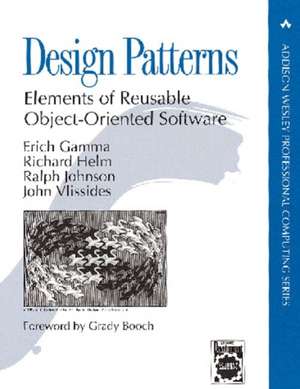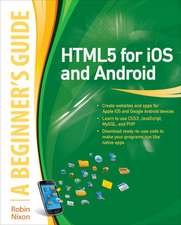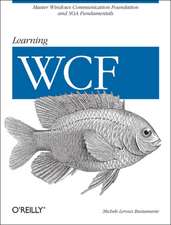Design Patterns: Elements of Reusable Object-Oriented Software
Autor Erich Gamma, Richard Helm, Ralph Johnson, John M. Vlissidesen Limba Engleză Hardback – 3 oct 2005
Capturing a wealth of experience about the design of object-oriented software, four top-notch designers present a catalog of simple and succinct solutions to commonly occurring design problems. Previously undocumented, these 23 patterns allow designers to create more flexible, elegant, and ultimately reusable designs without having to rediscover the design solutions themselves.
The authors begin by describing what patterns are and how they can help you design object-oriented software. They then go on to systematically name, explain, evaluate, and catalog recurring designs in object-oriented systems. With Design Patterns as your guide, you will learn how these important patterns fit into the software development process, and how you can leverage them to solve your own design problems most efficiently.
Applying UML and Patterns: An Introduction to Object-Oriented Analysis and Design and Iterative Development, 3/e
Craig Larman again delivers a clear path for students to learn object-oriented analysis and design through his clear and precise writing style. Larman teaches newcomers to OOA/D learn how to "think in objects" by presenting three iterations of a single, cohesive case study, incrementally introducing the requirements and OOA/D activities, principles, and patterns that are most critical to success.
| Toate formatele și edițiile | Preț | Express |
|---|---|---|
| Hardback (2) | 326.74 lei 17-23 zile | +28.86 lei 7-13 zile |
| Addison-Wesley Professional – 30 noi 1995 | 326.74 lei 17-23 zile | +28.86 lei 7-13 zile |
| ADDISON-WESLEY – 3 oct 2005 | 514.25 lei 3-5 săpt. | +69.61 lei 7-13 zile |
Preț: 514.25 lei
Preț vechi: 642.81 lei
-20% Nou
98.40€ • 103.01$ • 81.42£
Carte disponibilă
Livrare economică 15-29 martie
Livrare express 01-07 martie pentru 79.60 lei
Specificații
ISBN-10: 1405837306
Dimensiuni: 260 x 212 x 78 mm
Greutate: 2.9 kg
Ediția:1
Editura: ADDISON-WESLEY
Colecția Pearson Professional
Locul publicării:Harlow, United Kingdom
Descriere
Design Patterns: Elements of Reusable Object-Oriented Software, 1/e
Capturing a wealth of experience about the design of object-oriented software, four top-notch designers present a catalog of simple and succinct solutions to commonly occurring design problems. Previously undocumented, these 23 patterns allow designers to create more flexible, elegant, and ultimately reusable designs without having to rediscover the design solutions themselves.
The authors begin by describing what patterns are and how they can help you design object-oriented software. They then go on to systematically name, explain, evaluate, and catalog recurring designs in object-oriented systems. With Design Patterns as your guide, you will learn how these important patterns fit into the software development process, and how you can leverage them to solve your own design problems most efficiently.
Applying UML and Patterns: An Introduction to Object-Oriented Analysis and Design and Iterative Development, 3/e
Craig Larman again delivers a clear path for students to learn object-oriented analysis and design through his clear and precise writing style. Larman teaches newcomers to OOA/D learn how to “think in objects” by presenting three iterations of a single, cohesive case study, incrementally introducing the requirements and OOA/D activities, principles, and patterns that are most critical to success.
Textul de pe ultima copertă
Capturing a wealth of experience about the design of object-oriented software, four top-notch designers present a catalog of simple and succinct solutions to commonly occurring design problems. Previously undocumented, these 23 patterns allow designers to create more flexible, elegant, and ultimately reusable designs without having to rediscover the design solutions themselves.
The authors begin by describing what patterns are and how they can help you design object-oriented software. They then go on to systematically name, explain, evaluate, and catalog recurring designs in object-oriented systems. With Design Patterns as your guide, you will learn how these important patterns fit into the software development process, and how you can leverage them to solve your own design problems most efficiently.
Each pattern describes the circumstances in which it is applicable, when it can be applied in view of other design constraints, and the consequences and trade-offs of using the pattern within a larger design. All patterns are compiled from real systems and are based on real-world examples. Each pattern also includes code that demonstrates how it may be implemented in object-oriented programming languages like C++ or Smalltalk.
0201633612B07092001
Notă biografică
Dr. Erich Gamma is technical director at the Software Technology Center of Object Technology International in Zurich, Switzerland. Dr. Richard Helm is a member of the Object Technology Practice Group in the IBM Consulting Group in Sydney, Australia. Dr. Ralph Johnson is a faculty member at the University of Illinois at Urbana-Champaign's Computer Science Department.
John Vlissides is a member of the research staff at the IBM T. J. Watson Research Center in Hawthorne, New York. He has practiced object-oriented technology for more than a decade as a designer, implementer, researcher, lecturer, and consultant. In addition to co-authoring Design Patterns: Elements of Reusable Object-Oriented Software, he is co-editor of the book Pattern Languages of Program Design 2 (both from Addison-Wesley). He and the other co-authors of Design Patterns are recipients of the "1998 Dr. Dobb's Journal" Excellence in Programming Award.
0201633612AB09122003
Cuprins
- 1. Introduction.
- 2. A Case Study: Designing a Document Editor.
- 3. Creational Patterns.
- 4. Structural Pattern.
- 5. Behavioral Patterns.
- 6. Conclusion.
- Appendix A: Glossary.
- Appendix B: Guide to Notation.
- Appendix C: Foundation Classes.
- Bibliography.
- Index.











